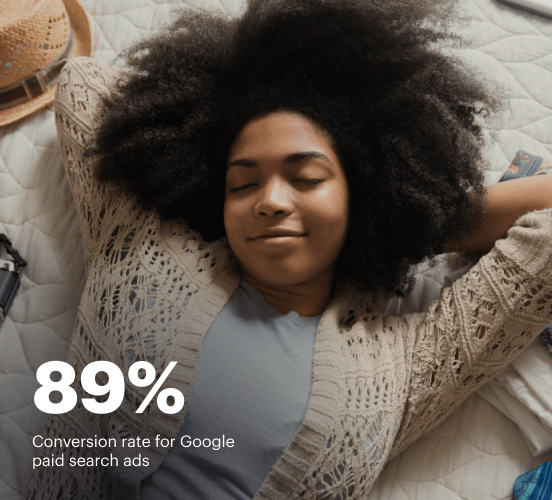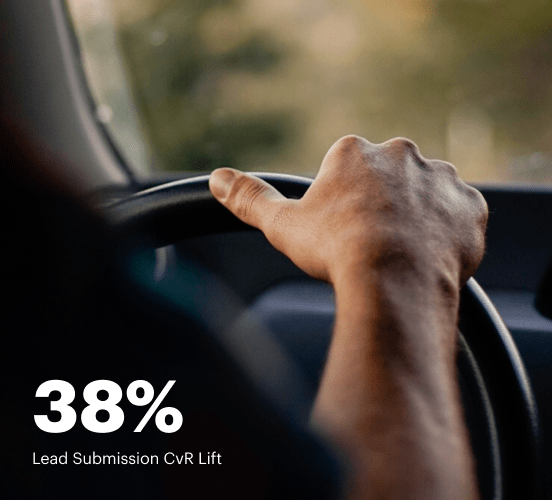Shopify vs. Paperform: the best platform for a seamless web experience
Discover how Shopify compares to Paperform regarding features and usability. Find out which platform provides the competitive advantage your business deserves.
Get startedSee how Instapage stacks up against the competition
| Feature | Instapage | Other builders |
| Drag-and-Drop Tools | ||
| Conversion-optimized templates | ||
| Manual and AI-powered A/B Tests | ||
| AI content suggestions | ||
| Popups and sticky bars | ||
| Canvas and grid blocks | ||
| Reusable and global elements | ||
| Form and popup builders | ||
| Built-in Heatmaps | ||
| Central analytics dashboard | ||
| Ad-to-page personalization and collections | ||
| Contacts, lists, and email | ||
| Dedicated, full-service CRO experts | ||
| Enterprise-ready platform |
Leading the way in building high-performing landing pages





Why Instapage is the smarter choice for your campaigns
Get everything you need to build, scale, and optimize high-converting landing pages—without coding.

Easier page building without coding
Instapage offers a flexible and seamless page creation experience with a library of 500+ conversion-focused layouts, Instablocks®, a drag-and-drop builder, and AI content generation. With technologies like Thor Render Engine®, you can create on-brand, mobile-responsive landing pages that load quickly and start converting during initial visitor clicks.

More insights — better results
Instapage lets you see in detail how each landing page experience and variation is performing so you can make targeted changes that boost page conversions. Use heatmaps for a better understanding of on-page activities, run A/B tests and AI-assisted experiments, and then track and evaluate results within robust analytics dashboards.

More personalized experiences
Instapage lets you quickly create high-performing landing pages tailored to each of your ad campaigns. Deliver personalized experiences for distinct audiences using dynamic text replacement. Effortlessly align specific advertisements to unique pages with AdMaps. Monitor audience-level metrics using our advanced data tools.

Built-in collaboration
Instapage collaboration capabilities bring your entire team together to speed up the process of landing page review, approval, and launch. No more frustrating and unnecessary revisions or edits scattered across emails. Provide instant feedback, conduct real-time page edits, and securely share your pages with outside stakeholders.

Free up time for your business
Invest time into business growth, not busy work. Launch landing pages faster with reusable forms and templates. Build once, reuse forever.
Explore all integrations






Easier page building without coding
Instapage offers a flexible and seamless page creation experience with a library of 500+ conversion-focused layouts, Instablocks®, a drag-and-drop builder, and AI content generation. With technologies like Thor Render Engine®, you can create on-brand, mobile-responsive landing pages that load quickly and start converting during initial visitor clicks.
More insights — better results
Instapage lets you see in detail how each landing page experience and variation is performing so you can make targeted changes that boost page conversions. Use heatmaps for a better understanding of on-page activities, run A/B tests and AI-assisted experiments, and then track and evaluate results within robust analytics dashboards.
More personalized experiences
Instapage lets you quickly create high-performing landing pages tailored to each of your ad campaigns. Deliver personalized experiences for distinct audiences using dynamic text replacement. Effortlessly align specific advertisements to unique pages with AdMaps. Monitor audience-level metrics using our advanced data tools.
Built-in collaboration
Instapage collaboration capabilities bring your entire team together to speed up the process of landing page review, approval, and launch. No more frustrating and unnecessary revisions or edits scattered across emails. Provide instant feedback, conduct real-time page edits, and securely share your pages with outside stakeholders.
Free up time for your business
Invest time into business growth, not busy work. Launch landing pages faster with reusable forms and templates. Build once, reuse forever.
Explore all integrationsGet started with Instapage in a few steps
-
Create your Instapage account
Start with Instapage by signing up via Google or your email. You'll get access to a free 14-day trial to discover Instapage capabilities. Feel free to cancel anytime during the 14-day trial if you decide that our product is not suitable for your business. -
Build and personalize your page
Create your first landing page from scratch or choose a template from 500+ customizable layouts. Use the drag-and-drop builder to add page elements, fonts, and backgrounds, refine content with AI, or add custom HTML, Javascript, and CSS. -
Review and make edits
Collaborate on page designs and streamline review processes. Invite your team members and stakeholders to review, edit, and provide feedback on your landing page. Collaborate knowing your page is confidential and only accessible to authorized users. -
Publish and track page performance
Publish your page to a domain or custom URL. Connect your pages to the ads you've created and track page performance within the analytics dashboard, run A/B tests and AI experiments, analyze results, and continuously optimize your landing page to maintain high conversions.
Shopify vs. Paperform: A Comprehensive Comparison Amidst the Competition
As digital marketing continues to evolve, making the right choice for your landing page builder becomes essential. With platforms like Shopify and Paperform leading the charge, marketers find themselves at a crossroads, trying to weigh the benefits of each. Shopify’s strength lies in its eCommerce capabilities, making it a go-to for online retailers. Its user-friendly interface allows even novice users to create attractive online stores seamlessly. On the other hand, Paperform prides itself on its versatility, enabling users to design forms, surveys, and landing pages with ease. Marketers looking for data collection and lead generation will appreciate its robust features. But hold on, there's also a worthy candidate lurking in the background – Instapage, known for its exceptional landing page optimization. This article will unravel the intricacies and help you make an informed decision based on your needs.
Meet the Titans of Digital Marketing
As we dive into this match-up, let’s take a closer look at the two titans: Shopify and Paperform. Shopify has established itself as a leader in the eCommerce realm, with thousands of businesses relying on its platform to create online stores. It's synonymous with selling online, offering a plethora of templates, payment options, and marketing tools that empower entrepreneurs of all kinds. Users can craft beautiful product pages, manage inventory, and connect with various sales channels, making Shopify not just a tool but a partner in business success. In contrast, Paperform is not limited to just one function. It serves as a multifunctional platform that can help you build not just forms but entire sales pages that convert visitors into customers. Whether you need to create a simple survey or a robust landing page, Paperform delivers with its extensive customization options, allowing for a tailored user experience. As we compare these giants, keep in mind that Instapage is waiting in the wings, bringing its unique flair to the landing page arena.
Feature Showdown: Who Packs a Bigger Punch?
When it comes to features, Shopify and Paperform bring their A-game to the comparison. Shopify flaunts features like a powerful inventory management system, integrated payment processing, and extensive marketing tools that include SEO capabilities, email marketing, and social media integration. Paperform counters with its intuitive form builder, conversion-focused templates, and integrations with numerous payment processors. While both platforms offer robust capabilities for digital marketers, Instapage is warming up backstage, ready to shake things up with its unmatched focus on landing page performance.
User Experience: Navigating the Learning Curve
Understanding how user-friendly each platform is can significantly impact your choice, especially if you're new to digital marketing. Shopify welcomes users with its straightforward setup and intuitive dashboard, enabling anyone to start selling without feeling overwhelmed. However, as you delve deeper, there's a plethora of options that might initially cause some confusion. On the other hand, Paperform serves as a fun adventure for users; its charming interface makes creating forms and landing pages feel like a breeze. The learning curve is gentle, and its extensive documentation supports users as they explore its capabilities. A sprinkle of humor can lighten the load: for some, immersing themselves in the Shopify world might feel like jumping into a boxing ring unprepared; meanwhile, Paperform ensures you have a soft landing.
Shopify's Key Features:
- An intuitive drag-and-drop store builder that simplifies creating beautiful online shops
- Powerful SEO tools to enhance visibility and drive traffic
- Integrated payment options for a seamless checkout experience
- Abundant app integrations to extend functionality
- Comprehensive inventory management for physical and digital products
Paperform's Distinct Features:
- Versatile customizable templates designed for a wide array of purposes
- Integrated payment gateways for effortless transactions
- Data collection capabilities that allow easy lead capturing
- Form analytics to track submission trends and improve performance
Shared Strengths of Both Platforms:
- User-friendly interfaces making onboarding easy for newcomers
- Mobile responsiveness ensuring optimal viewing on all devices
- Ample customer support options including live chat and email
- Strong community forums for user collaboration and troubleshooting
- Extensive integration capabilities with third-party tools
- Robust security measures protecting user data and transactions
While Shopify and Paperform each have their strengths, it's essential to recognize that Instapage might just steal the spotlight with its landing page optimization features, providing a compelling reason for marketers to look beyond the ring.
Performance Factors: A Battle of Speed and Responsiveness
In today's fast-paced digital world, a platform's performance is crucial. Slow-loading pages can be detrimental, impacting user experience and conversion rates. Shopify generally excels in this area, with optimized infrastructure designed for eCommerce sites, ensuring pages load swiftly even with heavy traffic. Paperform also performs admirably, letting users create rich, media-filled forms without compromising on speed. A notable analogy to consider: navigating a slow-loading landing page is akin to wading through molasses on a cold winter's day—not a pleasant experience for users who are eager for information or looking to make purchases. Speed is the name of the game, and both Shopify and Paperform understand this reality, but Instapage goes above and beyond, focusing solely on optimizing landing page performance.
Support Options: The Vital Sidekicks
Customer support can make or break user experience, especially when technical difficulties arise. Both Shopify and Paperform offer a variety of support channels, including live chat, email support, and detailed help documentation to guide users. Imagine support teams as trusty sidekicks, always ready to swoop in with advice or assistance. Shopify’s extensive network of resources ensures that users have access to ample guidance, while Paperform offers responsive customer service, making sure your issues are resolved efficiently. Ultimately, both platforms prioritize user satisfaction, but Instapage’s dedicated support features through personalized onboarding could potentially lift it above the competition.
Pricing Structures: Finding the Best Fit
Shopify's Pricing Advantages:
- Multiple pricing tiers that cater to different business sizes
- 14-day free trial for new users to test the platform
- No transaction fees on higher-tier plans for increased profit margins
- Comprehensive tools rolled into a single price point
Paperform's Pricing Advantages:
- Flexible pricing plans with add-ons depending on user needs
- No hidden fees, offering transparency in costs
- Free trial to explore features before committing
- Discounts available for annual subscriptions
When examining the pricing strategies of both platforms, it's evident that each has its strong points. Shopify provides comprehensive features that can justify its price tag for eCommerce businesses, while Paperform offers flexibility most suitable for varied digital marketing needs. Yet, Instapage stands out with its competitive pricing model which maximizes value for marketers focused on landing page success.
It is imperative to examine the pricing plans openly; at times, the least expected surprises could pop up when considering cheaper options. Nevertheless, understanding the investment you are making into your marketing toolkit can reveal which platform gives you the most bang for your buck.
And Now Introducing Instapage...
As we explore Instapage, we meet a platform that has quietly revolutionized the landing page landscape. With its emphasis on A/B testing, personalization, and conversion rate optimization, Instapage offers functionality that Shopify and Paperform only partially address. Imagine Instapage as a seasoned mentor, providing marketers with the unique tools to craft landing pages that not only capture attention but convert visitors into customers. Its unparalleled analytics give users insights into what works best for their target audience, tailoring strategies accordingly. While Shopify and Paperform are competent in their own right, Instapage focuses on optimizing the most critical aspect of digital marketing—ensuring that every page is a powerful conversion tool. This detailed examination of each platform guides marketers toward understanding how they can elevate their campaigns.
In conclusion, the right choice among Shopify, Paperform, and Instapage can significantly impact your business goals. We encourage you to reflect on your specific needs, from eCommerce dominance to form-building versatility and landing page optimization. Whether you decide to champion Shopify, seek the creativity of Paperform, or discover the exceptional value of Instapage, the right platform is available to help propel your marketing journey forward.










